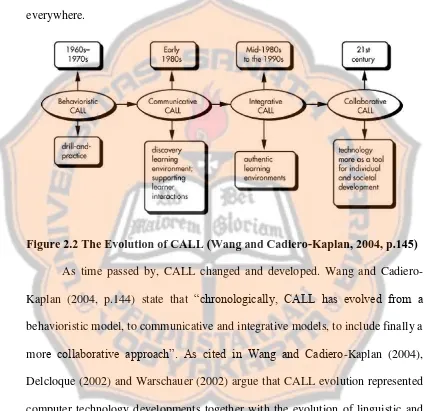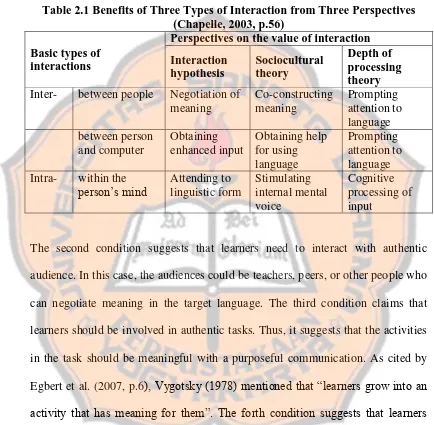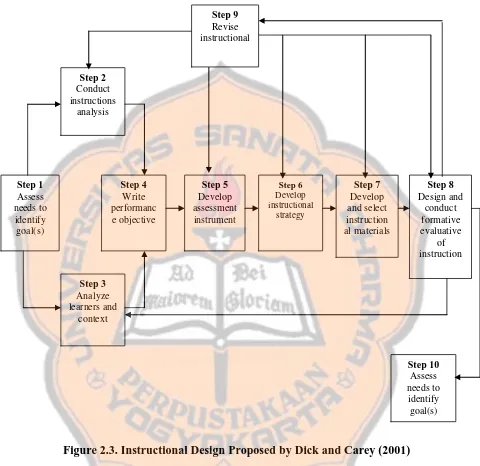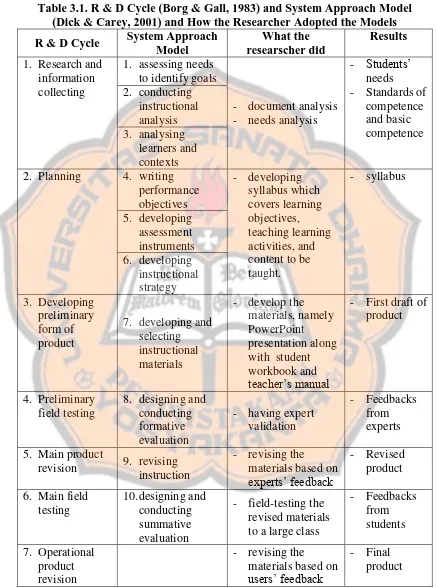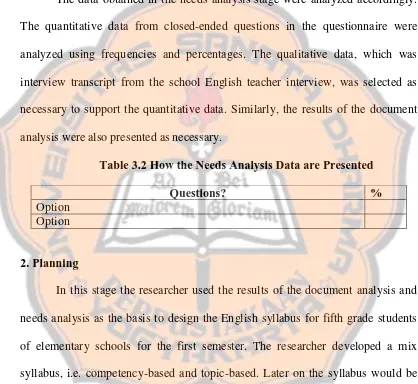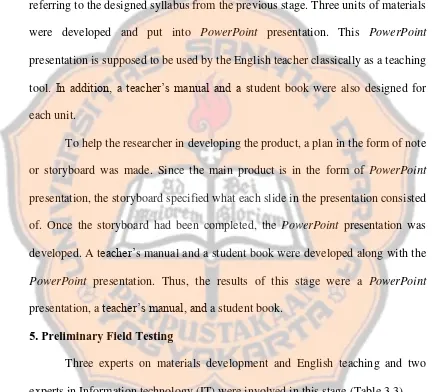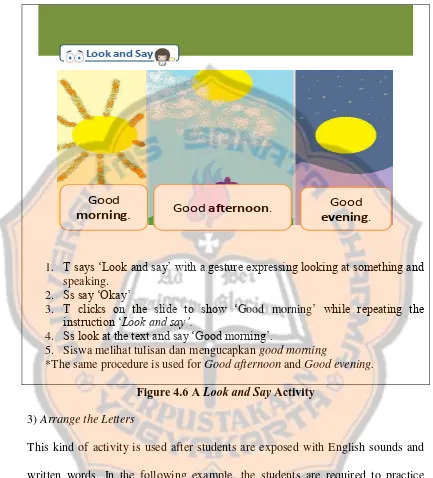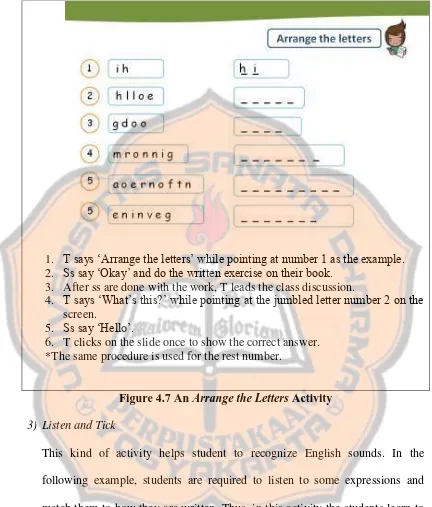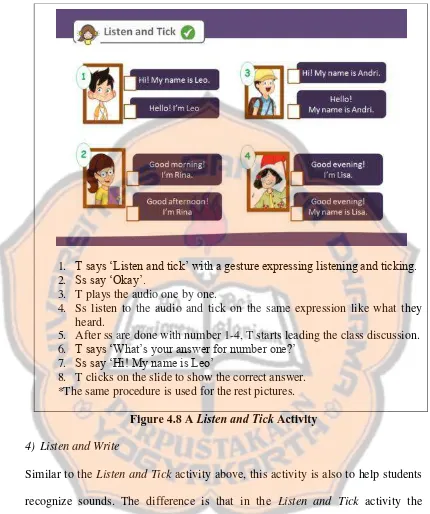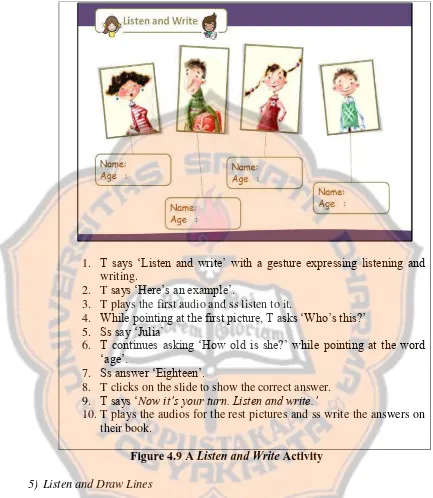xiv
ABSTRACT
Desi Trisiwiyanti. 2016. PowerPoint-based English Materials for Elementary School Students. Yogyakarta: The Graduate Program in English Language Studies, Sanata Dharma University
This study aims to develop PowerPoint-based English materials for fifth grade elementary school students with two research questions; (1) What do the PowerPoint-based English materials for elementary school students look like? and (2)Which pedagogical aspects of CALL are dominant in the materials?
This study employed two research designs. To answer the first research question, research and development (R&D) was employed. Seven steps of R & D cycles were conducted, namely research information collecting, planning, developing preliminary form of product, preliminary field testing, main product revision, main field testing, and operational product revision. To answer the second research question, a survey design was employed. From the two research designs, two kinds of data were obtained, namely quantitative and qualitative data. The quantitative data were from close-ended questionnaires, while the qualitative data were from the open-ended questionnaires, interview, and classroom observation. This study involved 3 experts on materials development, 2 experts on media / technology, and 21 fifth-graders.
The answer to the first research question is that there are six main parts of the materials, namely the Presentation Stage, Practice Stage, Production Stage, Review, and Reflection. Based on the questionnaire results of expert validation, the developed materials meet the principles of materials development, contain the eight pedagogical aspects in CALL, and meet the criteria of well-designed software. In addition, the answer to the second research question is that all pedagogical aspects in CALL were found dominant in the materials. This result was based on the user validation questionnaire and classroom observation during main filed testing. Those eight pedagogical aspetcs are (a) learners have opportunities to interact and negotiate meaning (x̅ = 4.6), (b) learners interact in the target language with an authentic audience (x̅ = 4.7), (c) learners are invovled in authentic tasks (x̅ = 4.5), (d) learners are exposed to and encouraged to produce varied and creative language (x̅ = 4.7), (e) learners have enough time and feedback (x̅ = 4.1), (f) learners are guided to attend mindfully to the learning process (x̅ = 4.7), (g) learners work in an atmophere with an ideal stress/anxiety level (x̅ = 4.5), and (h) learner autonomy is supported (x̅ = 4.1). All the mean scores were considered good and very good, thus the materials were acceptable for the students.
xv
ABSTRAK
Desi Trisiwiyanti. 2016. PowerPoint-based English Materials for Elementary School Students. Yogyakarta: Program Pasca-Sarjana Kajian Bahasa Inggris, Universitas Sanata Dharma.
Penelitian ini bertujuan untuk mengembangan materi Bahasa Inggris berbasis PowerPoint untuk siswa kelas lima sekolah dasar dengan dua rumusan masalah; (1) Seperti apakah materi Bahasa Inggris berbasis PowerPoint untuk siswa sekolah dasar? dan (2) Aspek pedagogik mana saja yang muncul dalam materi tersebut?
Penelitian ini menggunakan dua desain penelitian. Untuk menjawab permasalahan pertama, digunakan desain penelitian dan pengembangan. Tujuh langkah dalam penelitian pengembangan digunakan dalam penelitian ini, yaitu pengumpulan informasi (research information collecting), perencanaan (planning), pengembangan produk awal (developing preliminary form of product), uji lapangan awal (preliminary field testing), revisi produk utama (main product revision), uji lapangan utama (main field testing), and revisi produk operasional (operational product revision). Untuk menjawab pertanyaan kedua, desain survey digunakan. Dari dua jenis desain penelitian tersebut didapatkan dua macam data yaitu data kuantitatif dan data kualitatif. Data kuantitatif didapatkan dari kuesioner dengan pertanyaan tertutup, sedangkan data kualitatif didapatkan dari kuesioner dengan pertanyaan terbuka, wawancara, dan pengamatan kelas. Penelitian ini melibatkan 3 ahli materi, 2 ahli media / teknologi, dan 21 murid kelas lima sekolah dasar.
Hasil penelitian untuk rumusan masalah pertama menunjukkan bahwa terdapat 6 bagian utama dari materi, yaitu Presentation Stage, Practice Stage, Production Stage, Review, dan Reflection. Berdasarkan kuesioner validasi dari ahli, materi yang dikembangkan telah memenuhi prinsip pengembangan materi, bersisi 8 aspek pedagogik dalam CALL, memenuhi kriteria pengembangan perangkat lunak yang baik. Jawaban untuk rumusan masalah kedua adalah bahwa semua aspek pedagogik dalam CALL terdapat dalam materi yang dikembangkan. Hasil ini berdsarkan kuesioner validasi dari pengguna (murid) dan pengamatan kelas selama implementasi materi. Aspek tersebut adalah (a) siswa mampu berinteraksi dan merundingkan makna (x̅ = 4.6), (b) siswa berinteraksi dengan audiens otentik menggunakan Bahasa Inggris (x̅ = 4.7), (c) siswa dilibatkan dalam tugas-tugas otentik (x̅ = 4.5), (d) siswa didorong untuk membuat bahasa yang variatif dan kreatif (x̅ = 4.7), (e) siswa memiliki cukup waktu dan umpan balik (x̅ = 4.7), (f) siswa dibimbing secara sadar untuk mengikuti proses belajar (x̅ = 4.7), (g) siswa belajar dalam situasi yang ideal (x̅ = 4.5), (h) kemandirian siswa terdukung (x̅ = 4.1). Semua skor rata-rata tergolong baik dan sangat baik, sehingga materi yang dikembangkan dianggap sesuai untuk siswa.
POWERPOINT-BASED ENGLISH MATERIALS
FOR ELEMETARY SCHOOL STUDENTS
A Thesis Presented to
The Graduate Program in English Language Studies in Partial Fulfillment of the Requirements for the Degree of
Magister Humaniara (M.Hum) in English Language Studies
by
Desi Trisiwiyanti
146332015
SANATA DHARMA UNIVERSITY
YOGYAKARTA
i
POWERPOINT-BASED ENGLISH MATERIALS
FOR ELEMETARY SCHOOL STUDENTS
A Thesis Presented to
The Graduate Program in English Language Studies in Partial Fulfillment of the Requirements for the Degree of
Magister Humaniara (M.Hum) in English Language Studies
by
Desi Trisiwiyanti
146332015
SANATA DHARMA UNIVERSITY
YOGYAKARTA
vi
DEDICATION
I DEDICATE THIS THESIS TO YOU:
MY
PARENTS
, MYBROTHER
&SISTER
, MYBEST FRIENDS
FOR THE UNDERSTANDING AND ENCOURAGEMENT YOU PROVIDED DURING
ALL THESE YEARS OF STUDY.
vii
ACKNOWLEDGMENTS
.
I am highly thankful to my thesis advisor, Dr. B.B. Dwijatmoko, M.A., for his sage advice, insightful suggestions, and patience in the writing of this thesis. My gratitude also goes to FX. Mukarto, Ph.D and Dr. J. Bismoko for their valuable inputs during the thesis review and defense so that I could make appropriate revisions on my thesis. I would also like to thank Dr. E. Sunarto, M.Hum who has given me valuable feedbacks during the thesis defense. My sincere gratitude goes to all lecturers of the Graduate Program of English Language Studies of Sanata Dharma University for sharing their excellent knowledge and perspectives.
I would like to acknowledge the support and professional help of Ms. Josephine Sri Murwani, Ms. Ganggas Dwi Woro S., Ms. Hesti Widyasari, Mr. Idris Luthfi, and Mr. Sigit Nugroho. They are good materials developers and IT practitioners who have spared their time to provide feedbacks towards my designed product. I am also deeply thankful to the fifth grade students of SD N 1 Karangsari and the English teacher for their cooperation as my research respondents. I also really appreciate the cooperation of the principal, teachers, and staff of SD N 1 Karangsari.
viii
thanks also goes to Metta, Arik, Hesti, Binar, Topik, Sitta, Eren, Idris, and Afa for being my forever good friends.
My most important support for my work was the generous love from my beloved family; Bapak, Ibuk, Emas, Embak and also Azka, Nahda, Mbak Rani, Mas Ropik. They are the people who always reminded me to get rest at night, asked how I was, and cheered me up every time the muse left me. Their supports and prayers have been always a great power for me.
May God bless you all!
ix
TABLE OF CONTENTS
TITLE PAGE………... i
APPROVAL PAGE………... ii
DEFENSE APPROVAL PAGE………... iii
STATEMENT OF ORIGINALITY………... iv
LEMBAR PERSETUJUAN PUBLIKASI KARYA ILMIAH……….. v
DEDICATION PAGE………... vi
ACKNOWLEDGEMENTS.………..……….. vii
TABLE OF CONTENTS………...……….. ix
LIST OF TABLES………... xii
LIST OF FIGURES………. xiii
ABSTRACT……….……… xiv
ABSTRAK……….………...… xv
CHAPTER I. INTRODUCTION……….…….. ………. 1
A.Background to the Study…..……….……….. 1
B. ProblemLimitation…....…………...…... 4
C.Problem Formulation……...……… 5
D.Research Goals………..………...……….. 5
E. Benefits of the Study…..………. 6
CHAPTER II. LITERATURE REVIEW………... 7
A. Theoretical Review……...……….. 7
1. English for Elementary School Students……...……….. 7
a. Characteristics of Elementary School Students as Young Learners ……….. 7
b. Teaching English toElementary School Students……… 9
c. English in Elementary School in Indonesia ………. 14
2. Materials and Materials Development….……….………. 15
a. Materials ………... 16
x
3. CALL...……….……….……... 23
4. PowerPoint………..………..……… 28
5. Instructional Design……….. 31
6. PreviousStudies……… 35
B. Theoretical Framework.……… ……… 37
CHAPTER III RESEARCH METHOD……….……….... 39
A. Research Design……….………... 39
B. Developmental Procedure……….………... 42
1. Research and Information Collecting………. 42
2. Planning……….………... 43
3. Developing Preliminary Form of Product……….. 44
4. Preliminary Field Testing……… 44
5. Main Product Revision……… 48
6. Main Field Testing……….. 49
7. Operational Product Revision………. 51
CHAPTER IV RESULTS AND DISCUSSION ……….. 52
A.PowerPoint-based English Materials………. 52
1. Research and Development……… 52
a. Research and Information Collecting……….….. 52
b. Planning …………. ………..……… 57
c. Developing Preliminary Form of Product…………..………… 57
d. Preliminary Field Testing…………. ………. 60
e. Main Product Revision………. ……… 65
f. Main Field Testing………. ………... 67
g. Operational Product Revision ……….. 68
2. Features………. ………..……… 68
a. Presentation………. ………. ………. 70
b. Practice ………. ………. ……….. 73
c. Production………. ………. ……….. 79
d. Review………. ………. ……… 82
xi
B. Pedagogical Aspects………. ………. ……….. 84
CHAPTER V. CONCLUSIONS AND SUGGESTIONS……….. 89
A. Conclusions……….………... 89
B. Suggestions……….………... 90
BIBLIOGRAPHY.……….… 91
APPENDICES……….………...……….…. 95
Appendix 1:Standar Kompetensi dan KompetensiDasar….…...….…….. 95
Appendix 2: Needs Analysis Questionnaire………….……….….. 98
Appendix 3: Materials Validation Questionnaire……….…….. 101
Appendix 4: Media Validation Questionnaire….……….…….. 103
Appendix 5: User Validation Questionnaire ……….…….. 104
Appendix 6: Needs AnalysisInterview Guideline……….…….. 105
Appendix 7: Classroom Observation Guideline...……….…….. 106
Appendix 8: Open-Ended Questions Data from Materials Validation Questionnaire………... 107
Appendix 9 Open-Ended Questions Data from Media Validation Questionnaire……….….. 108
Appendix 10: Interview Transcript from Needs Analysis Stage…………. 109
Appendix 11: Field Notes from Classroom Observation………….…… 111
Appendix 12: Syllabus ……… 114
xii
LIST OF TABLES
Table 2.1 Benefits of Three Types of Interaction from Three Perspectives
(Chapelle, 2003, p.56)………...… 26 Table 3.1. R & D Cycle (Borg & Gall, 1983) and System Approach Model
(Dick & Carey, 2001) and How the Researcher Adopted the Models .…..….. 39 Table 3.2 How the Needs Analysis Data is Presented ..……..………..… 43 Table 3.3 The Description of Experts……….. ……….. ……….. …………. 44 Table 3.4 The Blueprint of The Materials Validation Questionnaire ..….….. 45 Table 3.5 The Blueprint of The Media Validation Questionnaire……… 46 Table 3.6 Quantitative Data Conversion (Suharto, 2006)………..………….. 47 Table 3.7 How the Quantitative Data from Materials Validation are
Presented………..………..………..………..………..………..……….…….. 48 Table 3.8 The Blueprint of The User Validation Questionnaire………...…… 50 Table 4.1 Standards of Competence and Basic Competence of English in
xiii
LIST OF FIGURES
Figure 2.1A Framework of Course Development Processes (Graves, 2000, p.3) 18 Figure 2.2 The Evolution of CALL (Wang and Cadiero-Kaplan, 2004,
p.145)……… 24
Figure 2.3. Instructional Design Proposed by Dick and Carey (2001)……… 33 Figure 3.1 An Example of how the Quantitative Data is Presented…………. 48 Figure 3.2 Observation Guideline………..………..………..………..………. 51 Figure 4.1 The Template of thePowerPointPresentation………..…………. 58 Figure 4.2 A Title Slide in thePresentationStage……….. 71 Figure 4.3 An Activity in thePresentationStage using a Video …………... 72 Figure 4.4 Figure 4.4 An Activity in thePresentationStage using Audio and
Pictures ………. 72
xiv
ABSTRACT
Desi Trisiwiyanti. 2016. PowerPoint-based English Materials for Elementary School Students. Yogyakarta: The Graduate Program in English Language Studies, Sanata Dharma University
This study aims to develop PowerPoint-based English materials for fifth grade elementary school students with two research questions; (1) What do the PowerPoint-based English materials for elementary school students look like? and (2)Which pedagogical aspects of CALL are dominant in the materials?
This study employed two research designs. To answer the first research question, research and development (R&D) was employed. Seven steps of R & D cycles were conducted, namely research information collecting, planning, developing preliminary form of product, preliminary field testing, main product revision, main field testing, and operational product revision. To answer the second research question, a survey design was employed. From the two research designs, two kinds of data were obtained, namely quantitative and qualitative data. The quantitative data were from close-ended questionnaires, while the qualitative data were from the open-ended questionnaires, interview, and classroom observation. This study involved 3 experts on materials development, 2 experts on media / technology, and 21 fifth-graders.
The answer to the first research question is that there are six main parts of the materials, namely the Presentation Stage, Practice Stage, Production Stage, Review, and Reflection. Based on the questionnaire results of expert validation, the developed materials meet the principles of materials development, contain the eight pedagogical aspects in CALL, and meet the criteria of well-designed software. In addition, the answer to the second research question is that all pedagogical aspects in CALL were found dominant in the materials. This result was based on the user validation questionnaire and classroom observation during main filed testing. Those eight pedagogical aspetcs are (a) learners have opportunities to interact and negotiate meaning (x̅ = 4.6), (b) learners interact in the target language with an authentic audience (x̅ = 4.7), (c) learners are invovled in authentic tasks (x̅ = 4.5), (d) learners are exposed to and encouraged to produce varied and creative language (x̅ = 4.7), (e) learners have enough time and feedback (x̅ = 4.1), (f) learners are guided to attend mindfully to the learning process (x̅ = 4.7), (g) learners work in an atmophere with an ideal stress/anxiety level (x̅ = 4.5), and (h) learner autonomy is supported (x̅ = 4.1). All the mean scores were considered good and very good, thus the materials were acceptable for the students.
xv
ABSTRAK
Desi Trisiwiyanti. 2016. PowerPoint-based English Materials for Elementary School Students. Yogyakarta: Program Pasca-Sarjana Kajian Bahasa Inggris, Universitas Sanata Dharma.
Penelitian ini bertujuan untuk mengembangan materi Bahasa Inggris berbasis PowerPoint untuk siswa kelas lima sekolah dasar dengan dua rumusan masalah; (1) Seperti apakah materi Bahasa Inggris berbasis PowerPoint untuk siswa sekolah dasar? dan (2) Aspek pedagogik mana saja yang muncul dalam materi tersebut?
Penelitian ini menggunakan dua desain penelitian. Untuk menjawab permasalahan pertama, digunakan desain penelitian dan pengembangan. Tujuh langkah dalam penelitian pengembangan digunakan dalam penelitian ini, yaitu pengumpulan informasi (research information collecting), perencanaan (planning), pengembangan produk awal (developing preliminary form of product), uji lapangan awal (preliminary field testing), revisi produk utama (main product revision), uji lapangan utama (main field testing), and revisi produk operasional (operational product revision). Untuk menjawab pertanyaan kedua, desain survey digunakan. Dari dua jenis desain penelitian tersebut didapatkan dua macam data yaitu data kuantitatif dan data kualitatif. Data kuantitatif didapatkan dari kuesioner dengan pertanyaan tertutup, sedangkan data kualitatif didapatkan dari kuesioner dengan pertanyaan terbuka, wawancara, dan pengamatan kelas. Penelitian ini melibatkan 3 ahli materi, 2 ahli media / teknologi, dan 21 murid kelas lima sekolah dasar.
Hasil penelitian untuk rumusan masalah pertama menunjukkan bahwa terdapat 6 bagian utama dari materi, yaitu Presentation Stage, Practice Stage, Production Stage, Review, dan Reflection. Berdasarkan kuesioner validasi dari ahli, materi yang dikembangkan telah memenuhi prinsip pengembangan materi, bersisi 8 aspek pedagogik dalam CALL, memenuhi kriteria pengembangan perangkat lunak yang baik. Jawaban untuk rumusan masalah kedua adalah bahwa semua aspek pedagogik dalam CALL terdapat dalam materi yang dikembangkan. Hasil ini berdsarkan kuesioner validasi dari pengguna (murid) dan pengamatan kelas selama implementasi materi. Aspek tersebut adalah (a) siswa mampu berinteraksi dan merundingkan makna (x̅ = 4.6), (b) siswa berinteraksi dengan audiens otentik menggunakan Bahasa Inggris (x̅ = 4.7), (c) siswa dilibatkan dalam tugas-tugas otentik (x̅ = 4.5), (d) siswa didorong untuk membuat bahasa yang variatif dan kreatif (x̅ = 4.7), (e) siswa memiliki cukup waktu dan umpan balik (x̅ = 4.7), (f) siswa dibimbing secara sadar untuk mengikuti proses belajar (x̅ = 4.7), (g) siswa belajar dalam situasi yang ideal (x̅ = 4.5), (h) kemandirian siswa terdukung (x̅ = 4.1). Semua skor rata-rata tergolong baik dan sangat baik, sehingga materi yang dikembangkan dianggap sesuai untuk siswa.
1
CHAPTER I
INTRODUCTION
This chapter presents the general information clarifying the background of the study, problem limitation, research goals, and benefits of the study.
A. Background
English is the first foreign language that is taught in Indonesian educational levels, including at the elementary school level. Public interest in English for Young Learners (EYL) has increased since the decentralization of education in Indonesia (Musthafa, 2010). This decentralization is earlier said to encourage local governments to make their own decisions regarding local contents for their schools. This explains why many elementary schools in many regions in Indonesia have included English as among the alternatives local contents of their school curriculum.
The position of English as a local content is emphasized in the School-Based Curriculum (SBC). This curriculum sets English as a local content subject for students in grade IV, V, and VI. This English teaching has two main goals, namely (1) to make learners able to communicate orally in a limited way to accompany action in school contexts and (2) to make learners aware of the essence and importance of English to increase the nation‟s competitiveness among
the global society (BSNP, 2006).
has their own consideration and authority to offer English classes, be it starting from the first grade of elementary school or from the fourth grade. For instance, all elementary schools in a sub-district in Yogyakarta provide English classes for students at grade IV, V, and VI (Lestari, 2012), while there are also elementary schools that teach English for students of all grades.
As English is a local content subject, there is no curriculum that is centrally developed. The responsibility to develop curriculum or syllabus and also learning materials are often left to individual teachers in schools (Hawanti, 2014). The wide availability of English textbooks in the market helps English teachers with the learning materials. However, teachers from schools that introduce English in the fourth grade need to modify the existing books in the market or to select them thoroughly. It is because the available books in the market are usually designed in six packages, i.e. for grade I, II, III, IV, V, and VI. Moreover, according to a study conducted by Lestari (2012), learning materials and learning media belong to the obstacles to the teaching of English in elementary schools.
3
Time has changed, teachers have evolved, and technology has played a big role in language teaching. Following is what Peacock (2013) said regarding the role of technology in language classrooms.
Teachers who spent their lives managing with a textbook, a tape recorder and a blackboard are now adept at using PowerPoint to present grammar, playing podcasts to practice listening skills, pulling texts off the world wide web to introduce reading skills and perhaps most ground-breaking of all – empowering students by giving them access to a wide range of web-based tools that allow them to publish work and engage with live audiences in real contexts. (Peacock, 2013, p.2)
The development of technology has influenced English language teaching practices, including those in elementary schools. The common term for this technology integration is Computer-Assisted Language Learning (CALL).
The presence of technology should have made teachers feel at ease in looking for, adapting, or designing learning materials. However, not all teachers have the same belief about technology. Tsai and Chai (2012) found some barriers in using technology faced by teachers, including the lack of adequate access, time, training, and institutional support. Additionally, they also found barriers related to teachers‟ personal and fundamental beliefs, which were teachers‟ pedagogical
beliefs, technology beliefs, and willingness to change.
educational settings thus it is not a new tool requiring a lot of adaptation and new skills from teachers. All in all, the researcher conducted a study that integrates technology in language learning especially English for young learners by developing PowerPoint-based English materials.
B. Problem Limitation
Due to the time constraint and access to literature, this study focused on developing PowerPoint-based English materials for elementary schools students grade V, especially for schools that introduce English in grade IV. It means that those fifth graders are in their second year of learning English. The materials model may not be suitable for elementary schools that introduce English in grade I whose fifth graders are in their fifth year of learning English. In addition, only three units of materials were developed based on the standards of competence and basic competence as well as students‟ needs.
The researcher limited the research on the development of the PowerPoint-based English materials. Thus, it is important to emphasize that there
was no experimental study which was conducted to measure students‟ English
5
C. Problem Formulation
This study focused on the following problems.
1. What do the PowerPoint-based English materials for elementary school
students look like?
2. Which CALL pedagogical aspects are dominant in the PowerPoint-based English materials for elementary school students?
D. Research Goals
Based on the problem formulation, this study had two goals. To start with, it was intended to present English materials for elementary school students utilizing technology, namely PowerPoint. Also, this study was intended to find out which pedagogical aspects in creating CALL materials as proposed by Egbert and Hanson-smith (2007) are dominant in the PowerPoint-based materials.
E. Benefits of the Study
This study gives benefits in two ways. Theoretically, this study provides principles regarding English teaching and English materials development utilizing technology. To be more detailed, this study provides principles on the teaching of English for young learners with the use of PowerPoint. It provides a new way of teaching using PowerPoint for enhancing students‟ English skills in general.
7
CHAPTER II
LITERATURE REVIEW
This chapter presents the review of the theories, the relevant studies, and the conceptual framework of this study.
A. Theoretical Review
This section includes the theory of English for elementary school students, materials and materials development, Computer Assisted Language Learning (CALL), PowerPoint, and instructional design.
1. English for Elementary School Students
A brief explanation related to characteristics of students in elementary school as language learners, teaching English to young learners, and English in elementary school in Indonesia is presented in this part.
a. The Characteristics of Elementary School Students as Language Learners
stage. It also mentions that in terms of accent, older learners can never achieve the same levels of proficiency.
Six characteristics of children learning a foreign language are proposed by Cameron (2001). Firstly, children actively construct meaning. Using their limited world knowledge, children try to find and construct a meaning and purpose for what adults say and ask. It suggests that teachers need to examine classroom activities from the children‟s point of view to help assess whether children
understand what to do. Secondly, children need space for language growth. This suggests that child‟s immediate potential is necessary for effective learning both
in language and cognitive development. Teachers can use language-using strategy, e.g. routines and scaffolding to help making space for children‟s growth. Thirdly, language use carries cues to meaning that may not be noticed. It is necessary for the children to know foreign language aspects that carry meaning. Since they do not benefit much from formal grammar, teachers need to find other ways to do this. Additionally, development can be seen as internalizing from social interaction. It suggests that language can grow as a child takes over control of language used initially with other children and adults. Lastly, children‟s foreign language learning depends on what they experience. In this case, when a teacher wants children to develop certain language skills, he or she needs to ensure that the children have experiences in lessons that will build those skills.
Teachers‟ beliefs about how children learn languages are necessary
9
join in the action, (6) children talk their heads off, and (7) children feel at home. In the end of the book chapter, Moon (2006, p.14) emphasizes that “children do not learn in just one way, but use all the different ways mentioned by teachers. However, children can only make use of these means if you develop the right kind of learning environment”. She explains the learning environment as the one
having enough exposure to various meaningful input, providing an atmosphere where learners feel free to take risks and experiment, providing an opportunity for learners to use the language to communicate with the teacher and other classmates and also to obtain feedback on their learning.
Brown (2001) clarifies the nature of children in five categories. First, as previously mentioned, children cannot grasp abstract talks since they are usually still in the concrete operations stage. Second, children have short attention spans to something considered to be boring. It suggests that children are more focused on the language for here and now and alo have a lot of natural curiousity. Third, children‟s all five senses need to be stimulated so that they can be engaged in a
lesson. Fourth, children are sensitive. Brown (2001, p.89) believes that “Children are in many ways much more fragile than adults. Their egos are still being shaped, and therefore the slightest nuances of communication can be negatively interpreted”. Lastly, children concern on a new language that can be used for here
and now. In other words, children have little appreciation to language tha does not have immediate benefit for them.
b. Teaching English to Elementary School Students
schools (Brewster, Ellis, & Girard, 2002) are briefly explained here. The first approach, audio-lingual, involves the use of repetition of new language which is often based on dialogues. Regardless its teaching-centered and out-dated state, this approach comes in modified versions that can be found in some countries. The next approach is total physical response (TPR), a teaching approach that involves activity and movement thus it does not force young learners to speak. It develops listening skills and introduces new language in a very visual and contextualized way. The communicative approach is an approach emphasizing the social nature of language learning and interaction. For children, this means that teachers engage learners in drawing, acting out, listening, talking, reading, or writing based on meaningful and contextualized tasks using the languages that have been prepared. The fourth approach, Task-based learning (TBL), is an attempt to improve on the communicative approach by trying to balance accuracy with fluency and by encouraging more authentic output from learners (Skehan in Brewster, Ellis, & Girard 2002). It covers three phases: pre-task preparation, the task itself, and language focus. The fifth approach is story-based methodology. Wright and Garvie in Cameron (2001) mention that stories are frequently claimed to bring many benefits to young learner classrooms, including language development. The last approach, cross-curricular, links second language to other areas of the curriculum such as Art, Physical Education, Mathematics, or Nature Study.
Young learners in an English as a foreign language class listen to various kinds of text. Most often, they listen to their English teacher‟s talking, singing,
11
2006). As listening is an active skill with many factors contributing to its difficulty, Pinter (2006) suggests that it is important in the early stages to avoid the sources of difficulty and introduce them only gradually. Some sources are the type and length of the text the young learners listen to, as well as the familiarity of the person they are listening to. In this case, listening to teachers is easier than to recordings since teachers can adjust the speed of their speech and modify their language.
Like Pinter, Brewster et al. (2002) also suggest that it is important to remember that listening is not a passive activity. Thus, they remind English teachers of young learners to scaffold, e.g., not merely asking students to „listen and remember‟, but directing students‟ attention to specific points that should be
listened for. Some activities can be used to support students‟ understanding more
effectively, such as those using visual aids. Brewster et al. (2002) provide some while-listening activities that can be applied to an English as a foreign language for young learners class. Those activities include listen and repeat, listen and discriminate, listen and perform actions, listen and draw/color, listen and predict, listen and guess, listen and label, listen and match, listen and sequence, listen and classify, and listen and transfer information.
„unanalyzed chunks‟ (Pinter, 2006). Brewster et al. (2002) mention that much of
the English that young learners learn to produce in the initial stages will be formulaic language which is language produced as whole chunks rather that word by word. Such language consists of simple greetings, social English, routines, classroom language, asking permission, and communication strategies. Meanwhile, many simple dialogues or drills can be used with adult learners. The following are some speaking activities that can be used for young learners: look, listen, and repeat; listen and participate; reading aloud; memory games; dramatization; rhymes, action rhymes, songs, chants, tongue twisters; retelling a story; guessing games; information gap; dialogues and role-play (Brewster et al. 2002).
According to the National Education Standards Agency (2006), one of the purposes of teaching English at elementary level is to make learners able to communicate orally in a limited way to accompany action (language accompanying action) in school context. It is in line with Brewster et al. (2002) who state that for young learners who are still learning in their L1, developing good levels of literacy in the L1 and good oral skills in the L2 are the most important objectives. Thus, whether reading and writing are introduced to young learners depend on many factors such as students‟ age, level of exposure to
English, L1 background, and ability to read in L1 (Pinter, 2006).
13
a. Sequencing letters, parts of words, whole words or sentences and sequencing them to make words, phrases, or sentences.
b. Matching or mapping pictures, and words or two halves of a sentence so that
they make sense.
c. Speaking using written prompt cards or language in a graphic organizer. d. Completing details/taking notes in a graphic organizer.
e. Reading and using a graphic organizer to make statements or ask questions. f. Classifying words to make lists or sets of various kinds. Classifying mixed up
detail from 2 stories.
g. Checking written statements. The students read sentences or short texts which
have deliberate mistakes in them to do with language, the ideas, the layout, the organization, and so on.
h. Understanding genre or text types. The students learn words for different kinds
of text.
c. English in Elementary Schools in Indonesia
The curriculum in Indonesia has changed several times. As stated earlier, the School-Based Curriculum (SBC) clearly mentions that English is a local content to be taught in grade IV, V, and VI. This curriculum also already sets the standards of competence basic competences of English for fourth, fifth, and sixth graders. The most recent curriculum, 2013 Curriculum which is known as K-2013, however, has caused some changes regarding the position of English at elementary school level. Unlike SBC, K-2013 does not state clearly what the position of English is. The two curricula are juxtaposedly implemented in Indonesia and it causes a chaotic atmosphere especially in the teaching of English as a foreign language in Indonesia (Tantra, 2015).
Although there was a rumor that English would be removed from the curriculum, many schools keep offering English classes for students, be it as a local content or an extracurricular subject. Some schools provide English for students in grade I to VI and some only from grade IV to VI. This does not matter as referring to the Decree of the Minister of Education and Culture No. 060/U/1993, the curriculum in elementary schools is adjusted to the condition and the need of the local area, agreed by the head of the Regional Office of the Education and Culture Department. For instance, all elementary schools in a sub-district in Yogyakarta teach English for students at grade four, five, and six (Lestari, 2012), while there are also elementary schools that teach English for students of all grades.
15
accompany action (language accompanying action) in school context. Secondly, it is to make learners aware of the essence and importance of English to increase the nation‟s competitiveness among the global society. It is also said that the English
teaching in elementary school is to prepare students to learn English in the senior high school level. In other words, from the English subject, elementary school students are expected to have interaction skills in English to support their classroom and school activities.
In terms of the teaching scope, English in elementary schools covers the skills to communicate orally in a limited way in the school context. This scope includes all the four English skills; listening, speaking, reading, and writing. In this case, the writing and reading skills are meant to improve the learning of oral communication. English is intended to develop those skills to make students able to communicate and to produce discourse in English in a certain literacy level (BSNP, 2006). In relation thereto, standards of competence and basic competences of English in elementary schools are set. In generals, the standards of competence of English for elementary school students grade IV, V, and VI include understanding very simple instructions with actions in a classroom context (listening), expressing very simple instructions and information in a classroom context (speaking), understanding very simple English writings in a classroom context (reading), and spelling and rewriting very simple English writings in a classroom context (writing).
2. Materials and Materials Development
Additionally, some criteria of good materials and principles in materials development are highlighted.
a. Materials
Some authors define the term „material‟ in different ways. Tomlinson (1998) defines this term as anything that is utilized to assist in teaching language learners. Although language learning materials are usually associated with coursebooks by many people, they can actually be in many forms other than coursebooks, e.g. a workbook, a cassette, a CD-Rom, a video, a photocopied handout, a newspaper, a paragraph written on a whiteboard (Tomlinson, 1998). Brown (2001) adds that although teachers can have activities without those aids, much of the richness of a language instruction is obtained from supporting materials. On the other hand, Graves (2000) finds blurring boundaries between materials, techniques, and activities. He argues that perhaps twenty years ago people might define materials as what a teacher uses and techniques and activities as how a teacher uses them. However, he believes that those definitions can no longer be applied. In fact, “part of the blurring of boundaries stems from the
different ways which one can conceptualize content. If you conceptualize content as a skill – learning to write, for example – then materials will of necessity include activities” (Graves, 2000, p.149).
17
materials also play a role as a structuring tool, meaning that textbook does not necessarily drive the teaching process, but it does provide the structure and predictability that are necessary to make the event socially tolerable to the participants. Allwright in Crawford (2002) mentions two key positions about the role of instructional materials as explained below.
The first – the deficiency view – sees the role of textbooks or published materials as being to compensate for teachers‟ deficiencies and ensure that the syllabus is covered using well thought out exercises. Underlying this view is the assumption that „good‟ teachers always know what materials to use with a given class and have access to, or can create them. They thus neither want, nor need, published materials. The - difference view, on the other hand, sees materials as carriers of decisions best made by someone other than the teacher because of differences in expertise. (Allwright in Crawford, 2002, 81)
Different kinds of instructional materials have different characteristics. Tomlinson (1998) mentions three kinds of materials in his book, namely multi-media materials, self-access materials, and supplementary materials. As clarified, multi-media materials utilize a number of different media such as print, graphics, video, and sound. They are usually interactive and provide learners with an opportunity to get feedback on the production of their written and spoken language. Self-access materials, on the other hand, are designed to be used independently by learners be it at home, in a library, or in a self-study center. Lastly, supplementary materials refer to any material that is designed to be used in addition to the core materials. Equally important to note, Tomlinson (1998) also talks about core materials for a course, which is course book. He states that “It aims to provide as much as possible in one book and is designed so that it could serve as the only book which the learners necessarily use during a course”
b. Materials Development
Knowing some definitions and roles of materials, one can say that materials development belongs to a teacher‟s responsibility. Graves (2000, p.150) states that for a teacher who designs a course, materials development means “creating,
choosing or adapting, and organizing materials and activities so that students can achieve the objectives that will help them reach the goals of the course”. Where
materials development fits in the process of a course design is illustrated in Figure 2.1, a framework of course development processes by Graves (2000). On the other hand, Tomlinson (1998) puts an emphasis on the language input. He argues that materials development refers to anything writers or teachers or students do to provide language input sources which makes the most of the supplying of information and or experience of language in ways designed to encourage language learning.
Figure 2.1 A Framework of Course Development Processes (Graves, 2000, p.3)
19
language acquisition which are relevant to the development of materials for the teaching of languages. First, materials should achieve impact. Impact is achieved when there are effects on the learners. The effects can be noticed from the learners‟ curiosity, attracts, intention, and interest to the materials. Second,
materials should help learners to feel at ease. Materials should make the learners feel comfortable with the materials. The learners will feel at ease when the materials have good input texts, well arranged tasks, and understandable language. Third, materials should help learners to develop confidence. It is suggested that materials developers try to put learners a little beyond their current proficiency. It can be done by engaging them in tasks which are stimulating; difficult and challenging but achievable too.
Tomlinson (1998) adds that what is being taught should be perceived by learners as relevant and useful. Materials should provide information that is needed by the learners. The points taught should be related to the learners‟
background study and needs. Also, materials should require and facilitate learner self-investment. Providing learners with choices of focus and activity, giving them topic control, and engaging them in learner-centered activities could help facilitating learner self-investment. The next principle is that learners must be ready to acquire the points being taught. Several things can be done to obtain this readiness, including by modifying the input so that it has some features which are a little be above each learner‟s current proficiency. Furthermore, materials should
linguistic features of the input. Materials should also provide the learners with opportunities to use the target language to achieve communication purposes. Good materials should facilitate learners‟ interaction by providing activities that creates
interaction.
Good materials should provide enough exposure of English. Tomlinson (1998) emphasizes that materials should take into account that the positive effects of instruction are usually delayed. It is suggested that materials developers need to recycle instruction and give frequent and sufficient exposure to the instructed language features in communicative use. Also, materials should take into account that learners differ in learning styles and in affective attitudes. This means that activities should be variable and accommodate all learning styles. Furthermore, materials should permit a silent period at the beginning of instruction. The point is that “the materials should not force premature speaking in the target language and
they should not force silence either” (Tomlinson, 1998, p.19). Next, materials should maximize learning potential by encouraging intellectual, aesthetic and emotional involvement which stimulates both right and left brain activities. It is also emphasized that materials should not rely too much on controlled practices. Lastly, Tomlinson (1998) suggests that materials should provide opportunities for outcome feedback. It means that it is very necessary for materials developers to ensure that language production activities have intended outcomes other than just practicing language.
In line with Tomlinson, Offord-Gray and Aldred (1998) also mention seven principles underlying materials development. Following are the principles.
21
b) Principle 2 - Teaching and learning materials need to be based on the knowledge of what is regarded as effective written communication in the discourse community.
c) Principle 3 - Teaching and learning materials need to reflect the communicative purposes for which the discourse community produces written texts.
d) Principle 4 - The forms and functions that characterize the internal linguistic structure of the texts need to be made explicit in the course materials.
e) Principle 5 - The course materials need to go beyond making the language explicit but provide a means by which learners can engage in a process of reconstruction
f) Principle 6 - Teaching and learning materials need to engage the learners in a process of developing skills for evaluating their own writing and becoming independent learners in the workplace.
g) Principle 7- The methodology and content of the teaching and learning materials need to be sensitive to learners‟ previous learning experience.
The right procedures of materials development will result in good instructional materials. Nunan (2004) argues that in order to create learning opportunities in the classroom, teachers should transform real-world task into pedagogical tasks. He proposes six steps or the sequence in developing units of work in a task-based classroom. The first step is schema building. In this step an instructional developer develops a number of schema-building exercises to introduce a topic, set the context for the task, and introduce some of the key vocabulary and expressions the students need to complete a task. The second step is to provide the students with controlled practice using the target language vocabulary, structures, and functions. The third step involves the students in intensive listening practice in which the students are exposed to authentic or simulated conversations. The fourth step focuses on linguistic elements. Here the students are supposed to take part in a sequence of exercise focusing on one or more linguistic elements. The next step is the time for the students to engage in freer practice. The students are encouraged to improvise, using whatever language they have to complete a task. Lastly, the students are introduced to the pedagogical task itself. It involves group work discussion and decision making task.
23
dependency. Within a lesson, on task should grow out of, and build upon, the ones that have gone before. The third principle is recycling. Recycling language maximizes opportunities for learning and activates the „organic‟ learning principle. The fourth principle is activating learning. Learners learn best by actively using the language they are learning. Based on the concept of experiential learning, learners learn best through doing – through actively constructing their own knowledge rather than having it transmitted to them by the teacher. The fifth principle is integration. Learners should be taught in ways that make clear the relationships between linguistic form communicative function and semantic meaning. The sixth principle is reproduction to creation. Learners should be encouraged to move from reproductive to creative language use. In reproductive tasks, learners reproduce language models provided by the teacher, the textbook or the tape. In creative tasks, learners are recombining familiar elements in novel ways. The last principle is reflection. Learners should be given opportunities to reflect on what they have learned and how well they are doing.
3. CALL
Beatty (2003, p.7) defines Computer Assisted Language Learning (CALL) as “any process in which a learner uses a computer and, as a result, improves his or her language”. Meanwhile, Egbert (2005, p.4) defines CALL as “learners
learning language in any context with, through, and around computer technologies”. Egbert puts an important emphasis in the definition of CALL,
(2013) adds that technologies have started to change how English is learned in the classroom. He claims that “the digital revolution in learning now threatens to undermine the classroom completely as a place of study” (Peacock, 2013, 2). This is related to the existences of mobile devices that gains credibility and popularity every day, thus allowing people to learn English not only in the classroom, but everywhere.
Figure 2.2 The Evolution of CALL (Wang and Cadiero-Kaplan, 2004, p.145)
25
The advances in educational computer applications these days have provided numerous resource for language classroom (Brown, 2001). Warschauer and Healy (as cited in Brown, 2001) summarize the benefits of integrating a computer component into language instructions. Those benefits are listed as follows.
1. multimodal practice with feedback 2. individualization in a large class
3. pair and small-group work on projects, either collaboratively or competitively
4. the fun factor
5. variety in the resources available and learning styles used 6. exploratory learning with large amounts of language data 7. real-life skill-building in computer use
(Warschauer and Healy as cited in Brown, 2001, p.145)
According to Egbert and Hanson-Smith (2007), teachers do not need a discrete theory of CALL to understand the role of technology in the classroom. Instead, a clear theory of SLA and the implication for the learning environment serves this goal which is to understand the role of technology. Thus, Egbert and Hanson-Smith (2007) propose eight conditions for optimal language learning environments. Those conditions are (1) learners have opportunities to interact and negotiate meaning, (2) learners interact in the target language with an authentic audience, (3) learners are involved in authentic tasks, (4) learners are exposed to and encouraged to produce varied and creative language, (5) learners have enough time and feedback, (6) learners are guided to attend mindfully to the learning process, (7) learners work in an atmosphere with an ideal stress/anxiety level, and (8) learner autonomy is supported.
suggests that learners need to interact with other people. This is important since learning is a social process. Chapelle (2003) has summarized three types of interaction along with the benefits from three perspectives. The summary is presented in the following table.
Table 2.1 Benefits of Three Types of Interaction from Three Perspectives (Chapelle, 2003, p.56)
Basic types of interactions
Perspectives on the value of interaction
Interaction
Inter- between people Negotiation of meaning
person‟s mind Attending to linguistic form
Stimulating audience. In this case, the audiences could be teachers, peers, or other people who can negotiate meaning in the target language. The third condition claims that learners should be involved in authentic tasks. Thus, it suggests that the activities in the task should be meaningful with a purposeful communication. As cited by Egbert et al. (2007, p.6), Vygotsky (1978) mentioned that “learners grow into an activity that has meaning for them”. The forth condition suggests that learners
27
the task goals. The sixth condition is that learners are guided to attend mindfully to the learning process. As cited by Egbert et al. (2007, p.7), Salomon (1990) claims that “learners must be motivated to take the opportunities presented to them and to be cognitively engaged as they perform them”, and this is what is
called as mindful. The seventh condition is learners work in an atmosphere with an ideal stress/anxiety level. This suggests teachers need to provide a more learning-center environment. Peyton (1990b) in Egbert et al (2007, p.7) adds that “more control to the learner removes the confounds of teacher, learner, school
personalities, styles, and goals”. The last condition suggests that learner autonomy
should be supported. This can be facilitated by setting a learner-center environment. However, modeling, feedback, and scaffolding from teachers remain necessary here.
In terms of the learner‟s role in CALL environment, Opp-Beckman in
Egbert and Hanson-Smith (1999) has divided them into four categories as follows. The first category is passive, in which „language learners are not engaged; they are not involved in any language-based, cultural, or technological communication (e.g. sleeping). The next category in receptive, in which „language learners function as an authentic audience, that is, as receivers (e.g., reading a newsgroup posting) or by lurking, that is, reading messages but not actively posting on an electronic list‟. The next category is active, where „language learners address an
exchanging e-mail with a keypal or taking part in a real-time electronic discussion)‟.
Opp-Beckman in Egbert and Hanson-Smith (1999) also mention three teacher‟s roles in CALL environment. First, teachers assess the students‟ level and
needs. They set expectations relative to students‟ language, cultural, and
technological experience. Secondly, teachers assess the students‟ access to technology. They should be realistic but creative, and find support. Lastly, teachers determine language and course goals. They plan how technology will enhance or improve what can already be done; integrate CALL purposefully and meaningfully.
One area that is related to CALL learning materials is usability testing which tests the acceptability of an educational software and its usability. According to Smith and Mayes (1996), usability is known as a critical determining factor in any new computer system or computer-based service‟s success. They emphasize that “Manufacturers who have made insufficient efforts t
build usability into simple technology such as video recorders and microwaves, have suffered in the market place. Consumers choose alternative, more effective products” (Smith & Mayes, 1996, p.6).
4. PowerPoint
PowerPoint is a common tool for presentation from Microsoft
29
used to make slides, handouts, and speaker notes. They add that PowerPoint is user friendly presentation software which helps users to design materials artistically and beautifully even if the user is not an art designer.
PowerPoint has some advantages when used in a teaching learning
process. Alfian (2010) believes that the advantages of PowerPoint in a teaching learning process are that they present materials in a way that is easily understood by learners, help teachers in delivering materials, help teachers with their time management in the classroom, and attract learners‟ attention. Additionally, Muthuchamy and Thiyagu (2011) mention six advantages of the use of PowerPoint as follows.
PowerPoint is best suited for (1) organizing and reorganizing information efficiently so that students see the structure of a classroom teaching session, (2) providing more time for listening and comprehending so that class time is used effectively, (3) illustrating concepts with pictures and other multimedia, (4) merging text, graphics, sound, multimedia, offering control and visual dynamics, (5) allowing the teacher to face the students (rather than facing the blackboard), and (6) presenting outline of information in a sequential manner. (Muthuchamy and Thiyagu, 2011, p.69)
In addition to the advantages above, Aakash & Al-Dersi (2013) claims that PowerPoint can be a tool to attract and sustain the attention of learners in an
English clasroom. This tool helps making EFL classroom more interactive thus creating a situation in which all languge pedagogies promote for better and meaningful teaching and learning (Aakash & Al-Dersi, 2013). Moreover, PowerPoint presentation can enhance teachers‟ confidence, help with
Muthuchamy and Thiyagu (2011) also proposed some steps to implement PowerPoint presentation in a classroom. The steps are as follow.
Selection. A teacher can select the PowerPoint slide in the following manner: (1) The slide should be attractive to the students. (2) The slide should be made according to the teacher and students‟ interaction. (3) The slide should be explaining the concept of lesson clearly.
Preview. The teacher should see the slides before the presentation: (1) The teacher should know whether the students are able to understand the slides. (2) If the teacher has a workbook for the lesson then he should read the explanation about the topic before going to the presentation. (3) The teacher should see the slides before the presentation and must prepare activities to motivate students. (4) The teacher should hive the related assignment task to the student before presenting the lesson.
Preparation. (1) The teacher should know the audience, equipment, and presentation room. (2) The teacher should begin with a joke or story or greeing. (3) The teacher should focus both on the slides and students. (4) The teacher should give a small introduction about the lesson then start the presentation.
Presentation. (1) The teacher set up the equipment and display the presentation clearly. (2) The teacher should interact with the student in the middle of the presentation. (3) The teacher should display the slides in the sequential order. (4) If it is necessary to take notes, the teacher should allow students to take notes during presentation.
Follow-up Activities. (1) Teacher should write the preview of the lesson in the black boar. (2) Teacher should make a conversation to the students after the completion of PowerPoint presentation. (3) Teacher should ask questions to students to know students knowledge/experience related to the content presented. (4) Teacher should create an opportuity for students to have research work. (5) Teacher should give assignment and homework to students.” (Muthuchamy and Thiyagu, 2011, p.67)
PowerPoint incorporates many features to enable users create
comprehensive and attractive presentation. Those features are Slider Transition, Color Schemes and Fonts, Auto Layout and Masters, Adding Pictures, Adding
Charts, Drawing on Slides, Equation, Word Art and other Ornaments, Adding
Multimedia Effects, Other Common Windows Feature (graphical user interface,
31
In relation to the description above, it is seen that PowerPoint can be regarded as a multimedia tool. The definition of multimedia actually varies in particulars but tend to be the same in substance. Mayer in Fahy (2005, p.3) defines multimedia learning as “the presentation of material using both words and
pictures”. A more detailed definition is offered by Roblyer and Scwier in Fahy
(2005, p.3); “A computer system or computer system product that incorporates text, sound, pictures/graphics, and/or audio”. From this definition it is clearer that PowerPoint is a multimedia tool.
As time changes and teachers evolve, technology is integrated in language classrooms. Multimedia instructions are believed to bring advantages to language classrooms. Mayer in Fahy (2005) articulates seven useful principles for guiding the design of multimedia instruction. Those principles are listed below.
1. Multimedia principle: Students learn better from words and pictures than from words alone.
2. Spatial contiguity principle: Students learn better when corresponding words and pictures are presented near rather than far from each other on the page or screen.
3. Temporal contiguity principle: Students learn better when corresponding words and pictures are presented simultaneously rather than successively. 4. Coherence principle: Students learn better when extraneous words,
pictures, and sounds are excluded rather than included.
5. Modality principle: Students learn better from animation and narration than from animation and on-screen text.
6. Redundancy principle: Students learn better from animation and narration than from animation, narration, and on-screen text.
7. Individual differences principle: A particularly important finding is that design effects are stronger for low-knowledge learners than for high knowledge learners, and for high-spatial learners than for low-spatial learners.
(Mayer in Fahy, 2005, p.14)
5. Instructional Design
program design, which is the strategic planning of a course a material developer follows. The stress of instructional design is making a plan to develop instructional materials and activities which are able to enhance an individual‟s
learning (Newby, et al., 2000). Meanwhile, Carr-Chellman (2011) defines instructional design for teachers as the process of creating classroom instruction through a systematic process including setting goals, creating learning objectives, analyzing students‟ characteristics, writing tests, selecting materials, developing
activities, selecting media, implementing and revising the lesson.
Many instructional design models exist for different levels of instructional designers and different instructional purposes. In general, they cover the same principles covering Analysis, Design, Development, Implementation and Evaluation, which is then known as ADDIE, proposed by Rodgers (2002). Similar to this model, Dick and Carey (2001) proposed the same basic models with more detailed explanation, which is known as System Approach Model. Gall, Borg, and Gall (2003) mentioned that Dick and Carey‟s model belongs to one of the most
widely used models in educational research and development. In this study, the researcher chose to follow the model proposed by Dick and Carey. Yet, this model is used to specify the research and development steps proposed by Borg and Gall (1983).
33 learning difficulties of students, or from other requirements for new instructions.
Figure 2.3. Instructional Design Proposed by Dick and Carey (2001)
able to begin the instruction. The result of this stage is a diagram that depicts the relationships among all of the skills that have been identified previously.
The third component is analyzing learners and contexts. In addition to instructional goals, materials developers also need to conduct a parallel analysis of the learners, the context in which they will learn the skills, and the context in which they will use the skills. The learners‟ current skills, preferences, and
attitude are determined in this stage.
The forth step is writing performance objectives. In this stage, instructional designers write specific statements of what learners will be able to do when they have completed after the instruction. It is based on the instructional analysis and the statement of entry behavior.
The fifth step is developing assessment instruments. After writing the objectives, instructional designers need to develop assessment that are parallel to and measure the learners‟ ability to perform what have been described in the
objective. It is suggested that the designers put an emphasize on relating the kind of behavior in the objectives to what the assessment requires.
The sixth component is developing instructional strategy. Based on the information from the previous stages, instructional designers need to identify the strategy that will be used in the instruction to achieve the final objectives. The strategy includes sections on pre-instructional activities, presentation of information, practice and feedback, testing, and follow-through activities.
35
to be chosen depends on the type of learning to be taught, the availability of existing relevant materials, and designers‟ developmental resources.
The eighth component is designing and conducting the formative evaluation of instruction. Once the draft of the instruction is completed, a series of evaluation is conducted. It is to obtain data to indentify how to improve the instruction. Three types of formative evaluation were proposed, namely one-to-one evaluation, small-group evaluation, and field evaluation.
The ninth component is revising instruction. This is the final step of the repeat cycle. The data from the previous stage, formative evaluation, are summarized and interpreted to identify difficulties experienced by learners in achieving the objectives. Thus, in this step the instructional strategy is reviewed and is included into revisions of the instruction to improve it.
The last component is designing and conducting summative evaluation. This evaluation is said not to be a part of the design process and only occurs after the instruction has been formatively evaluated and revised to meet the designers‟
standards.
7. Previous Studies
